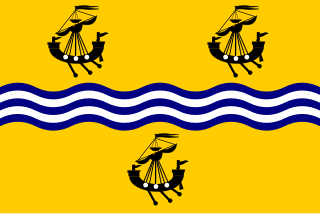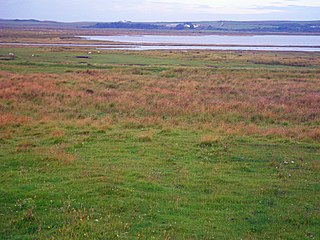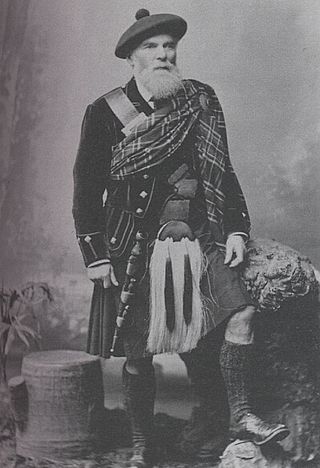Related Research Articles

The Outer Hebrides or Western Isles, sometimes known as the Long Isle/Long Island, is an island chain off the west coast of mainland Scotland. The islands are geographically coextensive with Comhairle nan Eilean Siar, one of the 32 unitary council areas of Scotland. They form part of the archipelago of the Hebrides, separated from the Scottish mainland and from the Inner Hebrides by the waters of the Minch, the Little Minch, and the Sea of the Hebrides.

North Uist is an island and community in the Outer Hebrides of Scotland.

South Uist is the second-largest island of the Outer Hebrides in Scotland. At the 2011 census, it had a usually resident population of 1,754: a decrease of 64 since 2001. The island, in common with the rest of the Hebrides, is one of the last remaining strongholds of the Gaelic language in Scotland. South Uist's inhabitants are known in Gaelic as Deasaich (Southerners). The population is about 90% Roman Catholic.

Benbecula is an island of the Outer Hebrides in the Atlantic Ocean off the west coast of Scotland. In the 2011 census, it had a resident population of 1,283 with a sizable percentage of Roman Catholics. It is in a zone administered by Comhairle nan Eilean Siar or the Western Isles Council. The island is about 12 kilometres from west to east and a similar distance from north to south. It lies between the islands of North Uist and South Uist and is connected to both by road causeways. Benbecula's main settlement and administrative centre is Balivanich.

Barra is an island in the Outer Hebrides, Scotland, and the second southernmost inhabited island there, after the adjacent island of Vatersay to which it is connected by the Vatersay Causeway. The island is named after Saint Finbarr of Cork.
Eriskay, from the Old Norse for "Eric's Isle", is an island and community council area of the Outer Hebrides in northern Scotland with a population of 143, as of the 2011 census. It lies between South Uist and Barra and is connected to South Uist by a causeway which was opened in 2001. In the same year Ceann a' Ghàraidh in Eriskay became the ferry terminal for travelling between South Uist and Barra. The Caledonian MacBrayne vehicular ferry travels between Eriskay and Ardmore in Barra. The crossing takes around 40 minutes.
Berneray is an island and community in the Sound of Harris, Scotland. It is one of fifteen inhabited islands in the Outer Hebrides. It is famed for its rich and colourful history which has attracted much tourism. It lies within the South Lewis, Harris and North Uist National Scenic Area, one of 40 such areas in Scotland which are defined so as to identify areas of exceptional scenery and to ensure its protection from inappropriate development.
Arisaig is a village in Lochaber, Inverness-shire. It lies 7 miles south of Mallaig on the west coast of the Scottish Highlands, within the Rough Bounds. Arisaig is also the traditional name for part of the surrounding peninsula south of Loch Morar, extending east to Moidart. Etymologically, Arisaig means "safe bay". It lies in the Scottish council area of Highland and has a population of about 300.

Morar is a small village on the west coast of Scotland, 3 miles (5 km) south of Mallaig. The name Morar is also applied to the northern part of the peninsula containing the village, though North Morar is more usual. The coastline of the area forms part of the Morar, Moidart and Ardnamurchan National Scenic Area, one of 40 such areas in Scotland, which are defined so as to identify areas of exceptional scenery and to ensure its protection by restricting certain forms of development.
Moidart is part of the remote and isolated area of Scotland, west of Fort William, known as the Rough Bounds. Moidart itself is almost surrounded by bodies of water. Loch Shiel cuts off the eastern boundary of the district and continues along part of the southern edge. The remainder of the southern edge is cut off by Loch Moidart. The north is cut off by Loch Morar and Loch Ailort.

Clan Macdonald of Clanranald, also known as Clan Ranald, is a Highland Scottish clan and a branch of Clan Donald, one of the largest Scottish clans. The founder of the Macdonalds of Clanranald is Reginald, 4th great-grandson of Somerled. The Macdonalds of Clanranald descend from Reginald's elder son Allan and the MacDonells of Glengarry descend from his younger son Donald. The clan chief of the MacDonalds of Clanranald is traditionally designated as The Captain of Clanranald and today both the chief and clan are recognised by the Lord Lyon King of Arms, the heraldic judge in Scotland.

Clan Macfie is a Highlands Scottish Clan.
Dr John Lorne Campbell FRSE LLD OBE was a Scottish historian, farmer, environmentalist and folklorist, and recognized scholar of both Celtic studies and Scottish Gaelic literature.

Loch Gruinart is a sea loch on the northern coast of isle of Islay in Scotland. Land at the head of the loch, Gruinart Flats, is a designated nature reserve owned by the RSPB. It is an important winter roosting site for barnacle geese. Ardnave Point is a coastal promontory near the mouth of the loch on the northwest of Islay.

The Battle of Traigh Ghruinneart or in Scottish Gaelic Blàr Tràigh Ghruineart or sometimes called the Battle of Gruinart Strand was a Scottish clan battle fought on 5 August 1598, on the Isle of Islay, in the Hebrides. It was fought between the Clan Donald and Clan Maclean. A tràigh or stand is the flat area of land bordering a body of water, a beach, or shoreline.
The Rough Bounds, in the Scottish Highlands, is the area of West Inverness-shire bounded by Loch Hourn, Loch Shiel, and Loch Moidart, consisting of the districts of Knoydart, North Morar, Arisaig and Moidart. The area is famous for its wildness and inaccessibility and remains very sparsely populated.

Lewis and Harris, or Lewis with Harris, is a single Scottish island in the Outer Hebrides, divided by mountains. It is the largest island in Scotland and the third largest in the British Isles, after Great Britain and the island of Ireland, with an area of 841 square miles (2,178 km2), which is approximately 1% of the area of Great Britain. The northern two-thirds is called [the Isle of] Lewis and the southern third [the Isle of] Harris; each is referred to as if it were a separate island and there are many cultural and linguistic differences between the two.
Siol Gorrie is a Scottish Clan and a branch of Clan Donald. The progenitor of Siol Gorrie is Gorrie (Godfrey), a son of John of Islay and Amy of Garmoran.

John Murdoch was a Scottish newspaper owner and editor and land reform campaigner who played a significant part in the campaign for crofters rights in the late 19th century
Iain mac Mhurchaidh, alias John MacRae, was a Scotland-born bard from Kintail, a member of Clan Macrae, and an early immigrant to the Colony of North Carolina. MacRae has been termed one of the "earliest Scottish Gaelic poets in North America about whom we know anything."
References
- 1 2 3 Townsend, Mike (2015). Walking on Uist and Barra: 40 coast, moorland and mountain walks on all the isles of Uist and Barra. Cicerone Press Limited. pp. 76-77. ISBN 9781849656931.
- 1 2 3 4 Carmichael, Alex A (1870). II. NOTICES OF TEAMPULL MICHAEL, KEALLUN, NORTH UIST, AND OF SCULPTURED STONES IN BEARNAREY, HARRIS, AND IN BENBECULA; AN "ABRACH" QUERN, AND QUARRY FOR QUERNS, HEISGEIR, NORTH UIST (PDF). Vol. 8. Society of Antiquaries of Scotland. pp. 278–280.
BY ALEX. A. CARMICHAEL, ESQ., LOCHMADDY, IN A LETTER TO "W. F. SKENE, ESQ., LL.D., F.S.A. SCOT
- 1 2 Gibson, John Graham (2002). Old and New World Highland Bagpiping. McGill–Queen's University Press. p. 137. ISBN 9780773522916.